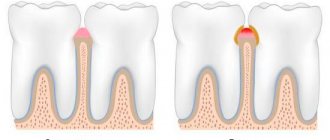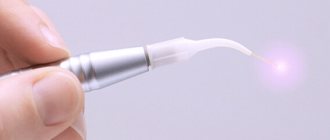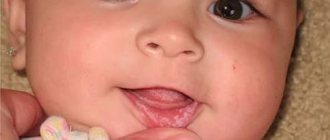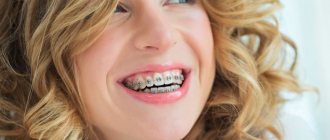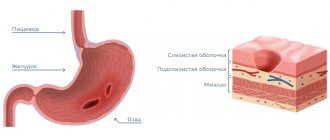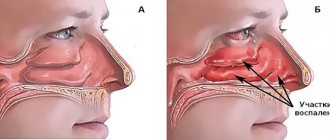Oral lichen planus, or stomatodermatosis , is a chronic disease of the oral cavity. It is characterized by abundant formation of papillomas, plaques and erosions in the oral cavity, accompanied by inflammatory and degenerative damage to the oral mucosa. This is one of the most common pathologies of the oral cavity, affecting the back of the cheeks, gums, lips, tongue and surface of the hard palate. The likelihood of this disease occurring largely depends on the individual predisposition of the patient. The disease is not transmitted by contact.
Causes of the disease
Lichen planus occurs under the influence of a number of factors, among which the most common is immuno-allergic. When the body's immunity decreases under the influence of external and internal factors, T-lymphocytes cannot cope with their protective function.
Factors that provoke the development of oral lichen planus include:
- Chronic stress;
- Strong shocks;
- Diseases of the gastrointestinal tract;
- Diabetes;
- Hypertension;
- Grynszpan syndrome;
- Injuries to the oral mucosa;
- Incorrectly installed dentures;
- Fillings that injure the oral mucosa;
- Prostheses made of dissimilar materials;
- Long-term use of tetracycline;
The risk group also includes patients whose work involves developing camera film or who come into contact with paraphenyldiamine.
THE WEBSITE IS UNDER CONSTRUCTION!!!
Grishpan-Potekaev syndrome (lichen planus) and modern views on its treatment
There are many skin diseases that can cause inflammation of the mucous membranes. The manifestation in a person of a typical form of lichen planus in the oral cavity, in combination with hypertension and diabetes mellitus, is called Grishpan syndrome , named after the author who described this syndrome in 1963. A year later, Potekaev described the manifestation of the erosive-ulcerative form of LP in a patient suffering from diabetes mellitus and hypertension.
Grishpan-Potekaev syndrome refers to dermatostomatitis, i.e. manifestations of LP occur both on the skin and in the oral cavity. Many serious diseases are based on various immune disorders, which exacerbate the sensitivity and susceptibility of the cells of the human body to the effects of pathogens and infections. Lichen planus is no exception . Experts classify Grishpan syndrome as a family disease. Most often, the second and third generations of relatives suffer from this type of dermatosis. The following main reasons for the appearance of lichen planus : - stress or diseases of internal organs provoke the body to release biologically active substances; - exposure to drugs or chemicals; - infection.
Symptoms of lichen planus
In patients with skin rashes, ulcers, blisters or plaques on the oral mucosa are also , although they can exist in isolation. Approximately twenty percent of patients experience nail changes. This symptom is characteristic of any form of lichen planus . The most severe lesions are observed in the most common diseases: erosive-ulcerative and bullous. Skin rashes may be accompanied by severe itching, and the nail plates become covered with tubercles or become deformed.
Causes of the disease
reliable information that fully explains the causes of Grishpan syndrome . Researchers tend to classify it as a group of autoimmune diseases. This version is convincingly confirmed by the fact that the most typical form of lichen planus usually accompanies transplant rejection. However, there are other theories according to which Grishpan syndrome occurs for neurogenic or viral reasons. A number of drugs have been noted that can provoke the appearance of lichen planus - tetracycline antibiotics, anticonvulsant and antimalarial drugs. The most significant factors that are important in the onset and development (pathogenesis) of the disease were also identified: - Neurological condition of the patient. Most often, lichen planus occurs in people suffering from phobias and low resistance to emotional stress. - Combination of gender and age. Women aged from forty to sixty years from the moment they enter menopause and beyond are susceptible to this disease. — the presence of chronic diseases of internal organs and the endocrine system. Together they can form a complex of symptoms described as Grishpan syndrome . — Statistics say that the development of LP can be triggered by foreign structures in the oral cavity, fillings of inadequate quality, sharp edges of teeth and dysbacteriosis. Lichen planus can also be a consequence of exposure to external factors on the body or a reaction to metabolic abnormalities .
Treatment options for LP
Treatment of Grishpan syndrome is carried out by a group of doctors, which should include an endocrinologist, a therapist and a dentist. Treatment of lichen planus is carried out in the therapeutic departments of dental clinics and depends on the form of LP. With a typical form of lichen planus and the patient has no complaints, general and local treatment is not prescribed. Treatment consists of sanitation oral cavity . Such patients should be monitored by a dentist and therapist. For other forms of LLP, procedures must be performed by high-level specialists who are well versed in the many nuances of this disease. When treating Grishpan syndrome, all possible risk factors (comorbidities, drug tolerance) must be eliminated and conditions that could influence the onset and development of the disease must be taken into account. The main therapy is a course of hydroxychloroquine and hormones. If severe itching is present, it can be relieved with antidepressants and antiallergic drugs. In parallel, a strengthening vitamin course (A, E) should be carried out. This reduces inflammation of the mucous membrane and normalizes cell division processes, allowing you to reduce the time required for hormonal treatment. In the case of chronic lichen planus , to the treatment . In some cases, non-drug treatment of LP, ultraviolet irradiation or laser use is possible. “ProDental No. 1” is one of the most popular dental clinics engaged in the diagnosis and treatment of diseases of the teeth and mucous membranes of the oral in adults and children. The modern equipment of the clinic, combined with the experience and highly qualified doctors with special training, allows us to achieve positive results in 100% of cases.
Symptoms of the disease
There are six types of oral lichen planus. This is a typical, exudative-hyperemic, hyperkeratotic, erosive-ulcerative, bullous and atypical form. They are united by the formation of foci of inflammation on the oral mucosa, the appearance of defects and erosions. In some particularly severe forms of the disease, the patient may complain of itching and burning sensation in the mouth and difficulty eating. In milder forms, the disease may not manifest itself at all.
Typical lichen planus is the most common form, occurring in half of patients. White nodules appear on the mucous membrane of the oral cavity. Merging, they resemble lace.
The esscudative-hyperemic form is characterized by the appearance of gray papillomas on the edematous mucous membrane.
The hyperkeratotic form is one of the least common forms, which is characterized by the formation of gray spots that rise above the affected surface. Over time, these plaque spots become rougher and flake off.
Erosive-ulcerative is the most severe form of the disease, occurring in 23% of cases. Multiple erosions and ulcers covered with fibrinous plaque appear on the lining of the oral cavity. There is a strong burning sensation in the mouth, and when trying to remove plaque, bleeding and pain occur.
The bullous form is a relatively rare variety, occurring in 3% of cases. Accompanied by the appearance of dense blisters, inside of which there is hemorrhagic exudate. After the bubbles open, erosions form.
Atypical form - occurs slightly more often than bullous - in 4% of cases. This form is characterized by dilation of the mouth of the salivary gland, as well as inflammation of the lips and gums.
Quite often, one patient can develop several forms of lichen planus in parallel. Often one form can flow into another. Ringworm is a chronic disease prone to relapse.
Introduction
Lichen planus (LP) is a T-cell-mediated chronic inflammatory disease of skin and mucous membranes of unknown etiology. Dermatosis is characterized by a papular rash on the skin and most cases occur between the ages of 30 and 60 years. However, LP is increasingly observed in children. It may affect the mucous membranes, especially of the mouth and genitals, and very rarely, the mucous membranes of the anus, nose, larynx, conjunctiva and urethra. Lesions of the oral mucosa occur in 50-70% of patients with LP and may be the only manifestation in 20-30% of cases. However, skin lesions in oral LP were observed in 15% of patients. The estimated prevalence of oral LP (OCLP) ranges from 0.5 to 4% of the general population and is more common in women. The purpose of this study is to analyze the etiopathogenesis, clinical manifestations, diagnosis and treatment of OCPL.
Etiopathogenesis
Although OCPL is thought to be a T-cell-mediated autoimmune disease, its cause remains unknown. Current evidence suggests that the disease is associated with alterations in cellular immunity caused by endogenous or exogenous factors that result from altered responses to autoantigens. The majority of activated T cells in the inflammatory infiltrate of ACPL are CD8+. Activated T cells of the inflammatory infiltrate are associated with increased production of Th1 cytokines (IL-1, IL-8, IL-10, IL-12, TNF-α), increase the expression of intercellular adhesion molecules (ICAM-1) on Langerhans cells and macrophages. Other mechanisms that may also be involved in the etiopathogenesis of the disease are due to mast cell degranulation and activation of matrix metalloproteinases. Moreover, some researchers believe that the chronic course of OCPL can be partly explained by the insufficiency of immunosuppressive mechanisms mediated by transforming growth factor beta. However, the reasons that lead to the occurrence of the process have not yet been fully elucidated.
The relationship between OCPL and hepatitis C virus is not stable, as the prevalence of this virus in patients varies across studies, ranging from 0% to over 60%, depending on the country where the studies were conducted. The incidence of HCV infection in patients with LP is high in Japan, Italy and Brazil and low in the USA, France, Scandinavian countries, UK and Germany. The reasons for the difference in the prevalence of HCV infection in different geographical areas have not been clearly explained, but it is thought to be related to differences in socioeconomic status and subject selection (mean age and sex) in the respective countries. Despite this geographic heterogeneity, support for the hypothesis that certain genetic alterations may contribute to the development of OCPL in a subgroup of patients with hepatitis C is provided by the increased incidence of HCV in patients with OCPL. A recent meta-analysis of the literature concluded that HCV is associated with a statistically significant risk for the development of OCPL, suggesting that the presence of either HCV or certain types of OCPL may be used as predictive markers for each other in certain geographic regions. Thus, it is suggested that investigation of liver disorders or hepatitis C in patients with ACLP should only be performed in individuals with a suspicious clinical and epidemiological history.
Genetic polymorphisms of some cytokines also seem to be associated with clinical manifestations of the disease. Interferon polymorphisms have been associated with LP with isolated OCLP without skin eruptions, and TNF-α polymorphism has been associated with forms that affect the oral mucosa and skin. OCPL is a genetically determined disease. However, these findings need to be confirmed by studies conducted in different geographical areas.
A severe form of the disease, the so-called “vulvovaginitis-gingival syndrome” in LP, is thought to be associated with the HLA class II allele (HLA-DBQ1).
An interesting fact is the presence of rashes identical to LP in graft-versus-host disease (GVHD). The clinical and histological findings of oral lichenoid lesions in GVHD are indistinguishable from idiopathic OCPL lesions. In GVHD, T cells from the tissue donor attack the minor histocompatibility complex antigens of the host cells. Thus, GVHD represents an interesting model in studying the pathophysiology of ACPL.
Some authors have also shown that oral lichenoid reactions can result from contact with dental restorative materials, especially those containing amalgams, metallic mercury, or ammoniacal mercury. This can be proven in cases in which replacing these materials leads to an improvement in OCPL.
The association with psychological factors varies among authors. Two points are being discussed: 1) mental disorders (anxiety, depression) are involved in the genesis of the disease; 2) mental disorders (anxiety, depression) are a consequence of chronic pain lesions. In a study of 16 patients with OCPD without mental complaints and without a subjective need for psychiatric care, a psychiatric examination showed that 5 of them had moderate mental disorders and one had signs of “neurosis.” An association with depression has been reported by some authors and refuted by others.
Clinical manifestations
OCPL manifests itself in the following forms: reticular, atrophic, papular, erosive, bullous and erythematous. These different clinical manifestations represent variations in the intensity and duration of the disease. These different forms may coexist, and the predominant clinical morphology may change over time in the same patient. OCPL is often bilateral and symmetrical, which distinguishes it from contact lichenoid reaction of the oral mucosa. Unilateral lesions of OCPL are rare and atypical. The mucous membrane of the cheeks and gums, the back of the tongue, and the mucous membrane of the lips are most often affected. The gingival mucosa often appears in the form of "chronic desquamative gingivitis." OCPL can appear at sites of mucosal injury (koebnerization).
Mostly lesions in OCPL are represented by small whitish opalescent and keratinizing (scales sit tightly and cannot be removed with a spatula) papules. The lesions may have different patterns. Lesions in the posterior portion of the tongue tend to be more keratinized, isolated, or plaque-forming due to the specific features of the epithelium in that portion. As a result of prolonged existence, such rashes are prone to atrophy. Depapilation of the tongue caused by atrophy can lead to taste changes with a burning sensation when contacting certain foods.
In the erosive form, bright red, well-demarcated erosions are observed, surrounded by typical papules. Rarely, with a rapidly progressing course, blisters may occur. The pain is usually intense and can affect the patient's quality of life.
Lesions identical to those described above may also appear on the vermilion border of the lips and usually affect this area diffusely. However, they almost always do not extend beyond the border between the red border and the skin of the lips, unlike some other cheilitis.
Manifestations of the form of “desquamative gingivitis” are common and can occur in isolation or with lesions in other areas. There are painful erosions on the gums that make it difficult to brush your teeth.
In dark-skinned individuals, residual pigmentation of the mucous membrane (pigmented LP) is possible.
Damage resulting from a reaction caused by contact of mucous membranes with dentures containing metal is indistinguishable from idiopathic LP, except that they are distributed asymmetrically on the mucosa, in areas of the mucosa in contact with dentures. There is no correlation between the extent and severity of oral and cutaneous lesions in LP. Associated extraoral rashes in the scalp, nails, conjunctiva, esophagus, larynx, urethra, vagina, vulva and perianal area can lead to severe dermatosis. The combination of severe forms of oral and genital LP has recently been identified as “vulvovaginal-gingival syndrome”.
Several publications, especially articles in dental journals, have focused on the “precancerous” potential of OCPL lesions. Indeed, some studies have been conducted on this topic, but with inconclusive results regarding possible “risks of malignancy.” In our opinion, the development of squamous cell carcinoma in LP occurs only in very old atrophic-scarring lesions, but this is rare.
Unlike cutaneous LP, which in most cases occurs with short-term exacerbations and almost always responds well to treatment or regresses after several months, OCPL is characterized by a chronic, long-term persistent course and resistance to therapy.
Diagnosis
The diagnosis is established on the basis of clinical and histological examination. Histopathological manifestations include acanthosis (in keratinizing lesions), atrophy (in old lesions), and absence (erosive lesions) of the epithelium. There is a superficial lymphocytic inflammatory infiltrate at the junction of the epithelium with the lamina propria. Biopsy material should preferably be taken from keratinized areas to avoid erosion, since they lack epithelium, making microscopic examination difficult.
Direct immunofluorescence allows one to distinguish OCPL from other mucosal diseases with an inflammatory component, especially lupus erythematosus, erythema multiforme, and drug rash. Most often, with OCPL, the presence of deposits of IgM and, less often, IgA and C3 in the subepithelial layers is detected.
Differential diagnosis
Depends on the morphology of the lesions. Reticular papular lesions should be differentiated from discoid lupus erythematosus, candidiasis, morsicatio buccarum (mucosal defects due to the habit of gnawing the mucous membrane of the cheeks) and other traumatic injuries, spots of secondary syphilis, with leukoplakia and incipient squamous cell carcinoma. Erosive LP should be differentiated from aphthae, mucosal pemphigoid, pemphigus vulgaris, drug reaction, erythema multiforme and acute lesions of lupus erythematosus. Differential diagnosis of the pigmented form is made with several causes of mucous pigmentation.
It is sometimes difficult to diagnose LP gingivitis in the absence of rashes in other areas of the skin and mucous membranes. Lesions of the mucous membrane of the gums with pemphigoid, pemphigus vulgaris and OCPL can manifest as desquamative gingivitis. Therefore, it is very important to perform histopathological examination and direct immunofluorescence for a correct diagnosis.
Treatment
Treatment of OCPL should be aimed at relieving symptoms and minimizing the manifestations of dermatosis. There are no known effective treatments for all cases of OCPL, because its cause is unknown. Therefore, professional experience is important here. The extent of damage and severity of symptoms should be taken into account. Thus, treatment is individual for each patient. Isolated reticular papular lesions are asymptomatic and do not require treatment. Consequences are observed in atrophic lesions. Erosion damage requires drug therapy, because accompanied by severe pain.
It is important to adhere to the rules of oral hygiene, especially with periodontal disease, when gum lesions are present. Tartar and plaque can stimulate local inflammation and aggravate disease activity. Replacement of metal teeth is recommended if a reaction to these substances is suspected. Improvement occurs in areas close to metal teeth.
More often, strong topical corticosteroids are prescribed - mouthwashes, ointments or Orabase pastes, used 2-3 times a day. It is important to note that creams are never recommended for use on the mucous membranes of the mouth, and Orabase pastes are only used on intraoral lesions (moist surfaces). For lesions on the red border of the lips, ointments should be used. Systemic oral and intralesional corticosteroids are almost never used for exclusively intraoral manifestations of LP, with the exception of severe erosive forms.
The potency of topical corticosteroids and their frequency of use should be reduced when clinical improvement is achieved. Intraoral use of topical steroids is safe and well tolerated. The most common side effect is oral thrush, which can be prevented by prophylactic use of topical nystatin and preventing the patient from sleeping with dentures.
Erosive gingival lesions are especially resistant. A rational selection of dentures is necessary. Excessive application of potent corticosteroids to the gum mucosa can lead to tooth retraction.
Topical calcineurin inhibitors (TCIs)—tacrolimus and pimecrolimus—were introduced in the treatment of ACPL early in the last decade. They have a local immunosuppressive effect, are an alternative to TGCS for OCPL, and have shown interesting therapeutic results. 0.1% cyclosporine ointment and 1% pimecrolimus ointment are indicated. The ointment should be applied 2 times a day. Adverse reactions include burning and tingling where the ointment is applied. Systemic levels of pimecrolimus and tacrolimus were detected after application to the oral mucosa. The theory is that these drugs may increase the incidence of cancer in OCPL because in addition to acting on the immune system, they also act directly on cells. For example, according to Becker et al, tacrolimus appears to block several important intracellular signaling pathways, especially those associated with the p53 protein, whose mutation is present in some types of cancer. Therefore, the systemic absorption potential and malignancy of such agents support the need for further long-term evaluation of these drugs.
Some authors have reported the effectiveness of topical retinoids in the treatment of ACPL, especially when used in combination with topical corticosteroids for reticular or hyperkeratotic lesions. Recently, imiquimod has been used in a small number of cases. We did not use these drugs.
Some anti-inflammatory drugs commonly used in dermatology, such as levamisole, sulfones, griseofulvin and chloroquine, have been used by several authors with questionable results and without scientific basis.
Immunosuppressive therapies such as PUVA, methotrexate, azathioprine and mycophenolate mofetil may be attempted in very severe and refractory cases.
Some specialists have attempted CO 2 laser treatment, but in our opinion, the method lacks a scientific basis for such indications (laser is not used in the treatment of cutaneous LP).
Patients should be monitored periodically due to the need to gradually reduce the frequency and dose of medications and, especially, monitor atrophic-scarring lesions.
Individuals with comorbid psychopathology, especially symptoms of depression or anxiety, may require specialized care.
Treatment
For different forms of the disease, a different course of medications is prescribed. If the disease is asymptomatic, drug treatment may not be necessary. If erosions and ulcers have already formed, it is necessary to begin treatment as quickly as possible to avoid worsening the condition.
Inflammatory processes are controlled by the use of corticosteroids. Local treatment is carried out to relieve pain and accelerate tissue regeneration. To avoid the development of candidiasis, antifungal drugs are prescribed.
Electrophoresis and phonophoresis are also effective. In rare cases, when erosions do not heal for a long time, surgical intervention is indicated.
In all cases, without exception, the oral cavity is sanitized and the source of inflammation is removed (for example, periodontitis, caries or pulpitis).
Oral lichen planus
The selection of medications is made based on the cause, severity of the process and associated pathologies. With an asymptomatic course and single papular elements, sometimes no medical intervention is even required. Erosive and ulcerative lesions, on the contrary, require timely treatment, otherwise there is a high risk of deterioration of the patient’s condition and infection. To stop the inflammatory process, topical corticosteroids are used. Oral forms are used only in extremely severe cases. At the first signs of improvement, the dosage of the drug must be reduced and subsequently discontinued to avoid side effects. In addition to topical steroids, local treatment of the disease includes pain relief (anesthetic solution or pyromecaine) and acceleration of regeneration (methyluracil, vitamin E in oil). To prevent candidiasis while using steroid hormones, it is recommended to take antifungal agents orally (fluconazole, Nystatin) or in the form of ointments (Griseofulvin, Ketoconazole). In some cases, topical calcineurin inhibitors (Tacrolimus, Pimecrolimus) may be prescribed for local immunosuppression. To speed up tissue regeneration, it is recommended to take multivitamins.
All patients with nervous disorders require sedative therapy (tincture of valerian and motherwort, Phenazepam, Sibazon). Patients with a burdened allergic history require hyposensitizing therapy (Claritin, Zyrtec, Erius). If the disease is accompanied by immunodeficiency, immunomodulatory therapy (Likopid, Myelopid, Interferon) is prescribed. To improve enzyme activity and accelerate the synthesis of nucleic acids, antimalarial drugs (Delagil, Rezokhin) are used.
Physiotherapeutic methods (electrical and phonophoresis) are also effective, and for some patients with long-term non-healing erosions, surgical intervention is recommended if there is a possibility of malignancy. In addition, all patients, without exception, need to undergo a complete sanitation of the oral cavity and eliminate all irritating factors (sharp edges of teeth, overhanging fillings, traumatic orthopedic structures) and foci of chronic inflammation (caries, pulpitis, periodontitis). It is necessary to give up smoking, alcohol, hot and spicy foods and adhere to a gentle diet. It is important to avoid nervous tension and avoid stress if possible.
Prognosis and prevention of oral lichen planus
Timely diagnosis and identification of causes make it possible to select pathogenetic therapy and carry out successful treatment. In this case, the prognosis of the disease is favorable. But since lichen planus of the oral cavity is a chronic dermatoses, the patient must be registered at a dispensary and regularly undergo examination by a dermatologist and dentist. The absence of the necessary medical intervention leads to aggravated course and complications. Prevention of lichen planus consists of following the requirements of oral hygiene, undergoing dental examinations once every six months, treating dental and somatic diseases, quitting smoking and other bad habits.
